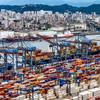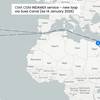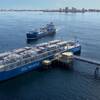Shell Europort Readies as North Sea Oil Diminishes
Deeper draft VLCC’s can now be berthed, and facilities for handling and storing crude oil in the Port of Rotterdam are also being further expanded.
At Shell Europoort, the jetty has been adapted to handle ships with an even deeper draught.
Following the Maasvlakte Oil Terminal (MOT), where three new tanks went into use at the end of 2011, Maatschap Europoort Terminal (MET) is now also expanding its tank capacity.
The extra tank capacity is not particularly related to an increase in supply, but gives the refineries greater flexibility, which makes them more competitive. As the extraction/production of North Sea oil is declining, crude oil will be brought in from still other areas in the future. These different types will be blended to specifications at MET.
In the past 10 years, supplies of crude oil have fluctuated between 92 and 102 million tons (98 million in 2012). During this period, the proportion of ‘North Sea oil’ fell from over 40 million tons to less than 20 million tons.
Since 2003, most crude oil has come from Russia. In 2012, ‘liquid bulk’, which includes crude oil, made up almost 50% of throughput in the port of Rotterdam.
Recently, the deepened berth at Shell jetty 104 in the Beneluxhaven was completed. The ‘pocket’ for the jetty (an area of 400 m x 80 m) was recently deepened by two metrsr to -23.65 m NAP. The bottom depth here is now identical to that of the MOT jetties.
The navigation path to the jetty has been dredged by 0.5 meters to -22.15 m NAP. This means that Shell can accommodate the very largest oil tankers, with a draught of 22 meters, allowing for more than 30,000 tons more crude oil per ship.












